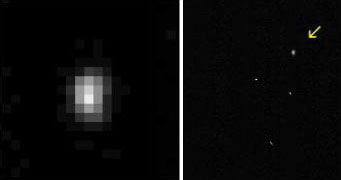T'was a time when finding a new planetary satellite brought praise and publicity to the discoverer. But those days are gone, apparently.
Word from the IAU's Central Bureau for Astronomical Telegrams is that observers have spotted two tiny moonlets around Jupiter. More on them in a moment, but I confess I only stumbled across the CBAT's June 1st announcement a few days ago. And the discoveries themselves were made 10 months ago, when Jupiter was enjoying its closest opposition to Earth at any time between 1963 and 2022.
In any case, the new moonlets are designated S/2010 J1 and S/2010 J2. Robert Jacobson, Marina Brozović, Brett Gladman, and Mike Alexandersen discovered the first one in images taken last September 7th with the 5-m Hale Telescope in California. Confirming images came the next night, and during the following few months, from Christian Veillet using the Canda-France-Hawaii Telescope atop Mauna Kea. The tables turned for the second find: Veillet spotted it on September 8th with the CFHT, and then the Palomar observers confirmed it in images they'd taken the previous night.
Both of these moons are tiny: S/2010 J1 is just 2 km across (magnitude 23.3 when found), and S/2010 J2 is half that size (magnitude 23.9). Both circle the planet in irregular orbits — highly inclined, highly eccentric tracks that carry them around in the direction opposite, or retrograde, to the spin of the planet itself and to the major satellites closer in.

Most of Jupiter's extended satellite family are too distant to be seen even by spacecraft in the vicinity. This view of Himalia, the brightest of itsouter moons, was snapped by the Cassini orbiter on December 19, 2000, from 2.7 million miles (4.4 million km) away.
NASA / JPL / Univ. of Arizona
"The two bodies are likely fragments of a larger body that was captured 4 to 4½ billion years ago and fragmented more recently," Gladman explains. As noted by outer-planet specialist Scott Sheppard, Jupiter is encircled by multiple families of small irregular satellites — perhaps fragments of somewhat larger retrograde-moving precursors that suffered head-on collisions and broke apart.
Eventually S/2010 J1 and S/2010 J2 will get mythological names. So will a dozen other Jovian moonlets, all discovered in 2003, that haven't been seen since discovery and are considered lost. Once their orbits are secure, the IAU's Working Group for Planetary System Nomenclature will have to dig up obscure offspring and other relatives of the mythologically prolific King of Planets.
Meanwhile, the new discoveries give Jupiter (now with 65 known moons) a little larger lead over Saturn (62) in the Solar System's Satellite Supremacy Sweepstakes. And they bring the total moon count for the eight major planets to 170, with dwarf planets Pluto, Eris, and Haumea chipping in six more. You can check them out in S&T.com's Guide to Planetary Satellites.
 2
2
Comments
Francisco
July 4, 2011 at 8:24 am
The reason is that when numbers become a statistic they become boring. 62 moons? 65 moons? And seriously we're calling large piles of rubble moons? This is also why Pluto got demoted. 8 Major planets has a nice ring to them... if we started including everying round object...well a planetary system of 30+ planets doesn't sound so special anymore does it?
By my personal definition Jupiter has just 4 moons worthy of the name. Saturn has Titan and a few choice objects. Mars has a couple of rocks called moons... really? Then Earth should have a few more moons as well seeing that it has a couple of NEAs close by.
Basically, in my book if it's not large enough to be round it's not worth putting it in the moon catalogue. Moonlet I guess is fine. But really this is more about aethestics than scientific classification. People just can't exzcited over something when we have built bridges that are larger than those two things.
You must be logged in to post a comment.
Douglas
July 14, 2011 at 1:11 pm
Bueno, ahora Júpiter sigue aumentando el número de lunas a su alrrededor.
You must be logged in to post a comment.
You must be logged in to post a comment.